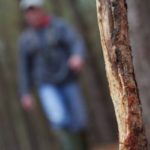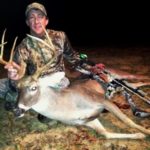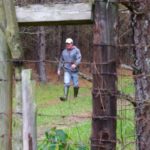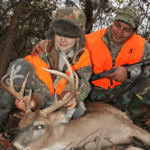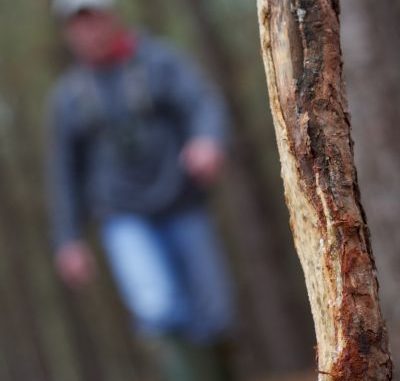
Don’t wrap the 2012-13 deer season until you do some scouting this month. It might provide a picture that leads to success next fall.
My imagination would not allow me to complete connect-the-dot books.
The problem wasn’t the scattered array of dots; they presented a nice little challenge. Instead, it was the parts of the picture the publisher had already filled in that lost me.
Why bother connecting the dots if I could already mentally see the big picture before I ever picked up a pencil?
Remove those pre-provided parts, though, and I would have been hooked.
That is why I was so interested in hearing how avid West Monroe deer hunter Curtis Simpson scouts for deer.
While listening to him talk, I realized he was connecting the dots on a blank canvas.
And like a kid who can hardly wait to finish one puzzle before starting another, Simpson starts connecting the dots for next season as soon as the current season ends.
That’s right. Simpson starts scouting for deer in February.
“There is no better time to figure out where you’re going to hunt next season than at the end of the current season,” Simpson insisted.
In his estimation, there’s no sense scouting for deer during the summer when they’re going to be somewhere else during the fall and winter.
“As soon as the velvet comes off their patterns change,” Simpson said.
In other words, by scouting for deer during February, Simpson finds where deer are likely to be next season.
“Whatever he did this year to make it through the season, he’s going to do it again next year because it worked,” Simpson explained. “Right now, everything looks like it will next hunting season.”
That’s why he tries to get all his scouting done by the end of February. March is too late because the woods start to green up, and everything changes.
Simpson first reflects on his successes and failures from the just-finished season.
“Do I need to find a different way to my stand?” he asked. “Do I need to find a different tree that lets me play the prevailing wind better?”
After accessing what he did right and what he did wrong, Simpson strolls through the woods with his GPS and smartphone in hand.
Although he doesn’t necessarily hunt scrapes and rubs, he still looks for them because he knows these are the kinds of places big bucks visit at night.
“A lot of times they show back up in the same places each year,” Simpson said. “What I want to find is where he’s coming from so I can catch him before he gets there.”
Understanding that big bucks in Louisiana typically check scrapes at night, Simpson tries to get as close to their bedding areas as he can so he can to get a shot before it gets too dark.
As he marks scrapes on his GPS, a line begins to appear over time as he mentally connects the dots.
“That’s his trail,” Simpson said. “Do the same thing with rubs, and you begin to get a picture of where he’s coming from, assuming he’s rubbing the same side of each tree as he travels.”
Ideally, Simpson wants to find a perfect path to the front door of a buck’s bedroom, but it often doesn’t work out that way in the real world.
Rather, he finds clusters of scrapes and rubs that are loosely connected. Although he tries to follow the dots to a bedding area, Simpson pays close attention to the large areas that sometimes go unconnected.
“There will be gaps in there somewhere,” he noted. “But here’s the kicker: You find a group here, a cluster here — what I want to hunt if I can’t get close to his bed is what’s in between those clusters.
“When he comes into a scrape line, he’s on full alert. When he’s traveling, not so much.”
After connecting the dots, Simpson begins searching for trees that would make for good stand locations and marks them with his GPS.
An avid bowhunter, Simpson looks for trees that will work for whatever winds he gets in February because he expects the same kind of wind next hunting season.
And he has to pay particular attention to shot distance.
“I’m also more worried about if it is open enough for me to get a shot,” Simpson said. “I don’t have the luxury bow hunting to sit on a right-of-way 200 yards long and hope something comes across.”
The key is for him to find everything a rifle hunter would look for, but in a more compressed area. And if he can’t find that spot, he gets out his chainsaw and makes it.
“I don’t get into cutting small limbs and stuff like that because they’re going to grow,” he explained, “but if I see trees that I need to get out of there or a brushpile that may be in the way, I’ll get rid of them in February.”
In the event that Simpson jumps a buck during his February scouting, he doesn’t see anything wrong with poking his head in the spot to see why that deer might have been there.
“If they spook, so what,” Simpson said. “I’m not worried about blowing them out, and if I do, I’ll go in there and see what’s holding him there.
“Heck, I might even take the time to follow him if I think it will help me kill him next season.”
Inviting himself right into a big buck’s lair might seem a little audacious, but Simpson doesn’t stop there. Thumbing his nose even more, he doesn’t even worry about masking his scent.
“It doesn’t matter if he winds you,” Simpson insisted. “There’s something there that he likes, and he’s going to be back next year. I would much rather blow him out in February and give him a seven-month break than blow him out in August or September.”
While he’s doing all this looking around, Simpson also keeps his eyes peeled for sheds lying on the ground. They are admittedly difficult to find in Louisiana because of thick cover, but he has found a few around food plots, pastures and trails over the years.
Sheds tell Simpson what made it through the season, and when he finds one near all the other buck sign he has found, he knows he’s found his hunting spot for next season.
“Once I think I’ve got the puzzle solved, I back out and don’t go back in until early summer when I will hang my stands,” Simpson explained. “If you put them up in February, you give the squirrels time to chew the straps and cushions.”
However, after hanging his stands, Simpson absolutely refuses to go back in until he decides it’s time to hunt the stand.
Does it work? Oh yeah.
Take, for example, a 128-inch 9-point Simpson killed a couple seasons ago.
During a squirrel hunt with his granddad a couple Christmases ago, Simpson kicked up two deer. He got a look at them crossing a logging road, and realized one of them was a buck he had been trying to kill.
“When he crossed the road, I got a good idea where he was coming from,” Simpson recalled, “so I went back in there that February to pinpoint a stand location. Early that summer I hung a lock-on stand and trimmed up a little bit and got out of there.”
Simpson returned on Nov. 21. It was the first time he had walked back down in the area, and he shot the buck at 6:30 that morning.
Returning to scout the same area last February, Simpson discovered another buck tearing up the same area.
“I shot that 8-point with my bow this season out of the exact same tree I killed the 9-point — almost to the week,” Simpson said. “So here’s the thing: If you get on something good — find a good spot — it can be good year after year.”
As Simpson has learned the last few years, there’s no better way to learn your property and how big bucks use it than scouting for next season as soon as this season comes to a close.
So, if you struggle with watching the same does and fawns year after year, grab a GPS or a smartphone and start marking some dots.
Connect those dots in your mind, and you’ll mentally start to see the big-buck picture appear right before your eyes.
Even without any pre-provided parts.
